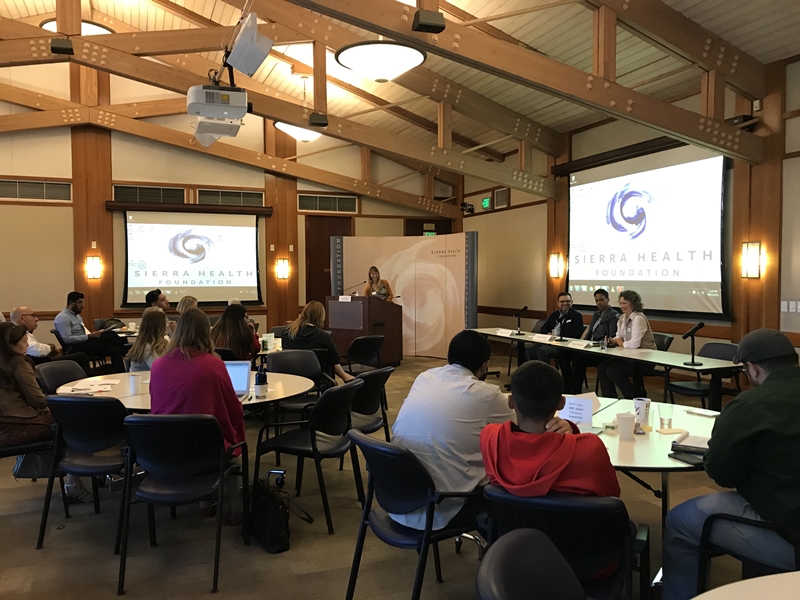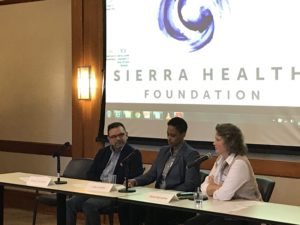By Elena Karoulina, Executive Director

Sustainable Solano Executive Director Elena Karoulina, far right, shares insight on a panel at the CalEPA gathering.
Recently a few Sustainable Solano team members had the privilege of spending a day with our fellow Environmental Justice CalEPA grantees and CalEPA and other state agencies’ officials and staff in Sacramento.
We were humbled by the depth and breadth of the organizations present at the meetings. From all over California – LA, Central Valley, Northern California and Bay Area — representatives of mostly grassroots organizations described their work of fighting against unfair environmental burdens in their communities, restricting and eventually banning pesticide use in California, building green infrastructure, providing youth education and leadership skills development, and supporting healing and personal transformation for inmates using permaculture as guiding philosophy. The community wisdom in the room was palpable — we all shared our honest stories of our accomplishments, opportunities and numerous challenges to further this work, from lack of funding and policy support to the unrealistic expectations of some funders to have measurable results in a short period of time. Our impact is not always easy to measure: How do you measure hope?
California Secretary of Environmental Protection Jared Blumenfeld opened the gathering and set the tone of our inquiry for the day: What does “successful” community capacity development look like? He masterfully identified our major modern adversaries: complexity and abstraction. The issues we are dealing with are so multifaceted and complex that it becomes increasingly difficult for the majority of the population to grasp them in their totality. Related to this is the abstraction of many concepts. For example, climate change is so profound and global, yet for most of us it is not yet a dire daily reality. Secretary Blumenfeld encouraged us to keep it personal and relative to our communities, to distill the essence of the issues and translate them into the place-based needs of the communities we work in, yet remain aware of how those fit into the complexity of our global challenges.
Blumenfeld talked about the need to reform the system and posted a question to all of us: How would this reform look? How can we ensure that technological advancements are placed in low-income, high-need communities first? Overall, we all felt appreciated and supported by the top leadership of the California EPA.
Throughout the day and long after we’ve been reflecting on what community capacity means for Sustainable Solano. The first question we have to answer is “capacity to do what?”

We, at Sustainable Solano, strive toward a new model, a vision for our human society built on the principles of Earth care, people care and fair share for a world that works for everyone. This new world is emerging all around us at the grassroots level, and it was very reassuring to hear from state officials that the question of a structural change is presenting itself on their level, which opens up a conversation about what that change will look like. It will take all of us, every level and all three major sectors of our society — business, government and civic — to work together to create a more sustainable future for all. We work on the ground, rooted in our neighborhoods, inspiring, educating and empowering our community members and providing tools and space to take heart-based actions toward the good of the whole.
What kind of community capacity supports this work? What would be a crucial characteristic we all need to have? We think it’s CONNECTION – to ourselves, to each other, to the world around us and to something larger than ourselves, whatever it might be for each of us.
We see the role of Sustainable Solano in enacting and supporting these connections through meaningful, tangible work in our communities. Every time you come to our events to plant trees, establish a permaculture food forest or install a greywater system, we are doing just that — seeding these vital connections all over the county.
This is exactly how we approach our Listening Circles project in Central Solano, funded by CalEPA’s Environmental Justice grant: We would like to bring to the communities mostly affected by the environmental pressures a balanced sense of urgency and agency, knowledge about environmental issues in their backyards, and practical, achievable, community-based solutions to fix the problems or at least ease the effects of them.
Looking forward to seeing you at our next community event!

